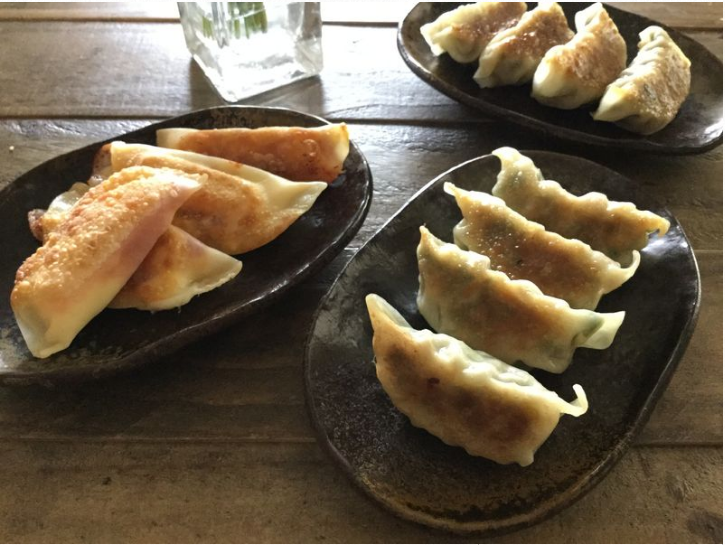Make comforting Japanese gyoza at home
Sign up now: Weekly recommendations for the best eats in town

Gyoza dumplings, and deep-fried snacks with gyoza skins.
PHOTO: MARI NAMESHIDA
Mari Nameshida
Follow topic:
(THE JAPAN NEWS / ANN) - Gyoza was one of the most popular dishes in my cooking class, and I often had requests for it. Even in the United States, where I live now, I can find frozen gyoza at local American grocery stores, so I guess it has become really popular in many places now. But nothing is better than homemade gyoza - it is seriously tasty and difficult to resist.
In my recipe, I use a lot of vegetables and a small portion of meat to make juicy and flavoursome gyoza. Even if you are a meat lover, please try it - you will be won over! Gyoza can be a snack, appetiser or main dish. I have them mostly as a main dish for lunch or dinner with rice and miso soup. It is so comforting.
Gyoza are Japanese dumplings that originated in China.
-
Mari's recipe for gyoza
-
Ingredients
For the filling:
200 grams ground pork
2 cabbage leaves, minced
100g nira garlic chives
½ naganegi long onion, minced
20 grams ginger, grated
1 garlic clove, grated
½ Tbs oyster sauce
1 Tbs sake
1 Tbs soya sauce
½ Tbs sesame oil
1 pack of gyoza wrappers (about 25 sheets)
For the dipping sauce:
3 Tbs soy sauce
1 Tbs rice vinegar
Chinese chilli oil (rayu)
200 grams ground pork
2 cabbage leaves, minced
100g nira garlic chives
½ naganegi long onion, minced
20 grams ginger, grated
1 garlic clove, grated
½ Tbs oyster sauce
1 Tbs sake
1 Tbs soya sauce
½ Tbs sesame oil
1 pack of gyoza wrappers (about 25 sheets)
For the dipping sauce:
3 Tbs soy sauce
1 Tbs rice vinegar
Chinese chilli oil (rayu)
Method
1. Place all the filling ingredients into a bowl and mix well by hand until somewhat sticky. Let it sit for 5 minutes.
2. Place one wrapper on your palm and spread about a tablespoon of the filling in the centre. Smear water along the edge of the wrapper with your finger. Fold in half with the filling in the middle. Pinch the edges of the semi-circle at several places to make pleats and create a seal.
3. Place the oil and dumplings, sealed-side up, in a single layer in a frying pan, preferably nonstick, over medium-high heat and cook until the bottoms turn golden brown.
4. Add about ¼ cup of water along the edge of the pan and cover. Let the dumplings steam until the water is gone, about 5 minutes.
5. Take the lid off and arrange on a serving plate. Pour the dipping sauce into a small dish and serve alongside the gyoza.
2. Place one wrapper on your palm and spread about a tablespoon of the filling in the centre. Smear water along the edge of the wrapper with your finger. Fold in half with the filling in the middle. Pinch the edges of the semi-circle at several places to make pleats and create a seal.
3. Place the oil and dumplings, sealed-side up, in a single layer in a frying pan, preferably nonstick, over medium-high heat and cook until the bottoms turn golden brown.
4. Add about ¼ cup of water along the edge of the pan and cover. Let the dumplings steam until the water is gone, about 5 minutes.
5. Take the lid off and arrange on a serving plate. Pour the dipping sauce into a small dish and serve alongside the gyoza.
The general idea is the same as Chinese dumplings in dim sum, but the texture and flavor is the big difference.
The skin is thinner than that of Chinese dumplings, so it is crispy on the bottom and juicy on the inside, which comes from the "fry-steam-fry" method. (We also have boiled gyoza in Japan, which we call suigyoza.)
I know Chinese dumplings have many variations, using different kinds of vegetables or meat, but Japanese gyoza fillings generally consist of a core set of ingredients - nira garlic chives, garlic and ginger for flavor, as well as cabbage and pork. As you can imagine, the flavour is very strong.
It takes a little practise and patience to master shaping the dumplings, but after you have made a few, you will quickly get the hang of it.
By the way, when you make gyoza, you will probably have either gyoza skins or gyoza filling left over.
I was trying to think of a good way to use them. I finally worked it out, and even the leftovers became as delicious as the gyoza. For the filling, I love to pan-fry it with egg and cooked rice to make fried rice. The filling is already flavoured, so you can add seasoning at the end only if you feel like it.
For the skins, you can play around with them because they do not have any flavour.
I often put cheese and ketchup inside and deep-fry or panfry them for a snack. I also sometimes put something sweet inside, such as a piece of banana with some chocolate.

